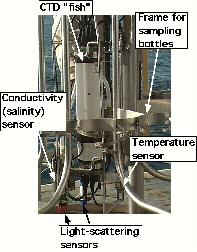| |
Science
Report:
Since we have
been talking a lot about CTD work during this trip, I thought it might
be helpful to show you a close -up picture of its various parts. The accompanying
figure shows the CTD package without the usual wall of large sampling
bottles that cover the outside and hide the sensors on the inside of the
frame. The "brain" of the CTD is an electronic package inside a large
white pressure case, called the "fish." Circuits inside the fish take
the power sent down the cable from the ship and make it usable by a variety
of sensors. These circuits also take input from the sensors and send it
back up the wire in a way it can be interpreted by computers in the ship's
lab. Inside the fish is a sensitive pressure sensor that measures the
weight of the water above the package and thus the depth of the CTD below
the sea surface-the "D" in CTD.
Outside the fish are several
other sensors. A temperature sensor measures the temperature of the seawater
with a precision of better than 1/1000 of a degree Celcius-the "T" in
CTD. A conductivity sensor measures the electrical conductivity of seawater-the
"C" in CTD. Seawater conducts electricity since it is a salt solution,
and measuring the conductivity of seawater, together with its temperature
and pressure, allows us to calculate its salinity. Also shown in the picture
are two light-scattering sensors. These sensors send a flash of light
into the seawater and measure the amount of light reflected back to a
light detector in the sensor. The amount of reflected light is a measure
of the number of tiny particles suspended in the water the CTD is moving
through. CTDs are one of the most common instruments used by oceanographers,
both to describe the temperature and salinity of ocean water and to carry
other sensors for specialized measurements. It's really the workhorse
of oceanographic research!
|
|

The CTD and all its parts. (click for full size)
|
|

